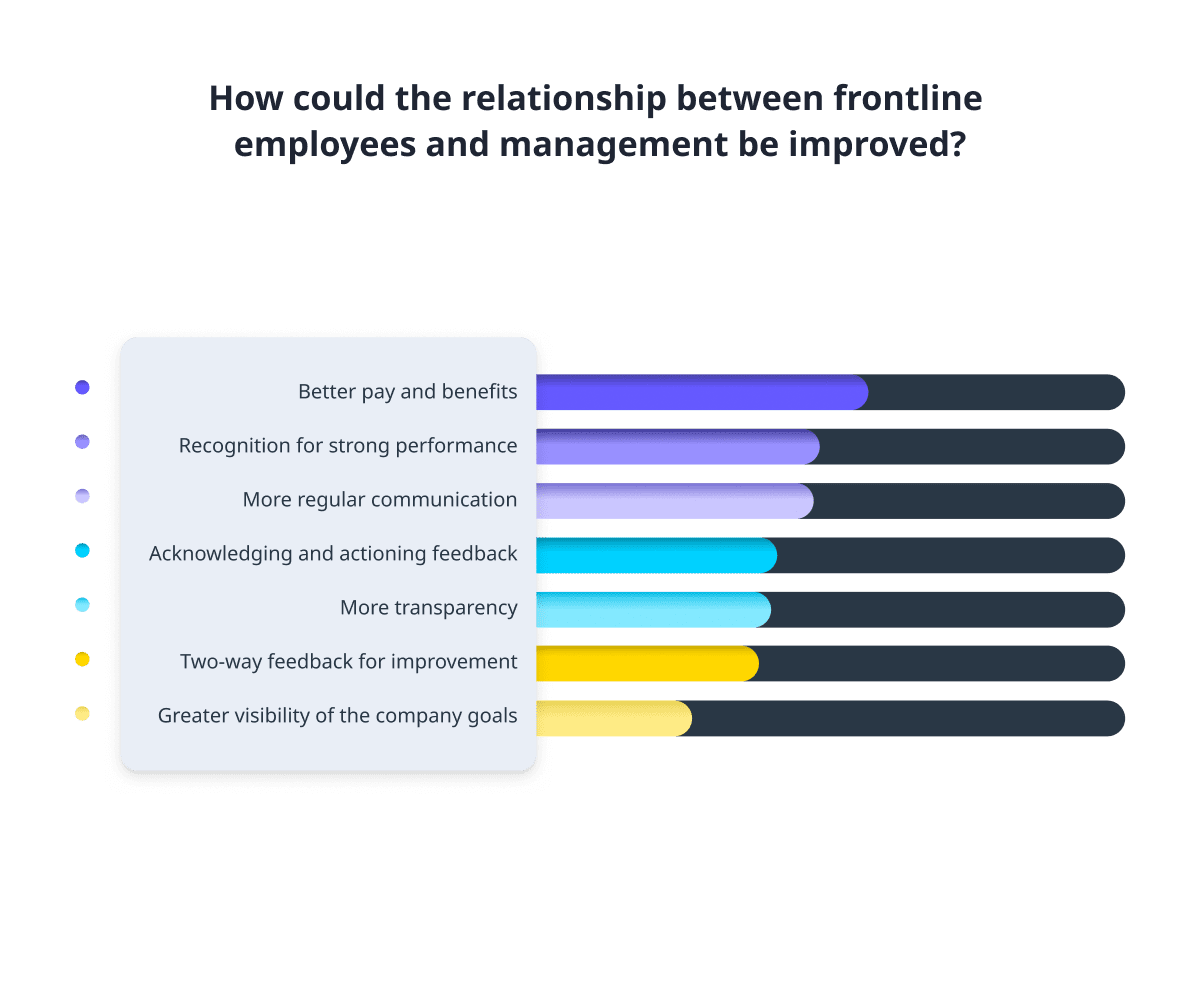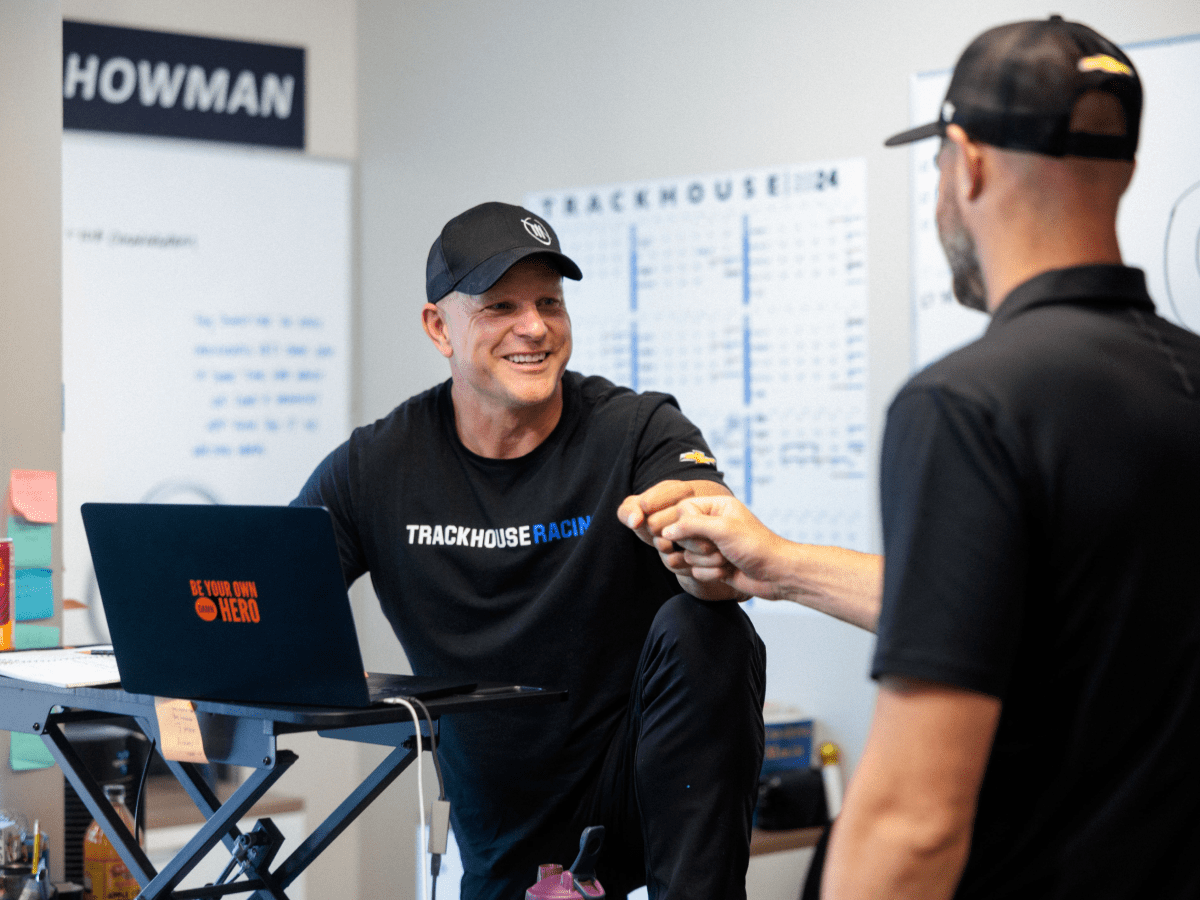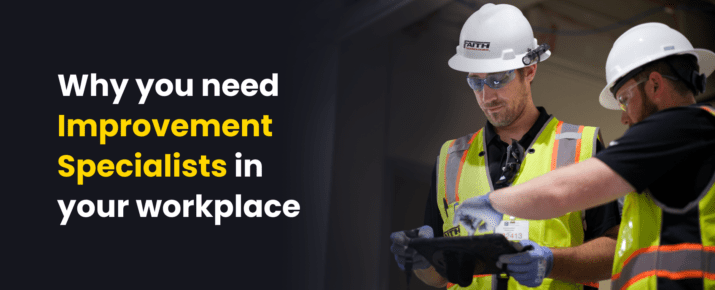How to improve employee-manager relationships: Pay, recognition and communication
Feedback From The Field | World Of Work | By | 29 Oct 2024 | 5 minute read

Workplace relationships can be tricky, and today’s pressures—rising costs, economic shifts, and higher expectations—only add to the disconnect between teams and management.
In fact, according to our recent Feedback from the Field report, 93% of workers believe the relationship between frontline employees and management in their organization could be improved.
When we asked frontline employees and management if they thought there was a disconnect at their workplace, over half (52%) of all workers believed there was an “us versus them” mentality, a feeling slightly stronger in management (55%) than in frontline employees (50%).
So, what’s causing this divide? More importantly, how can businesses close the gap? Our research suggests that pay, recognition, and communication are the keys to building better workplace relationships.

Pay: addressing the most immediate concern
It’s no surprise that pay is at the forefront of many workers’ concerns. With the rising cost of living, salaries are top of mind. According to our research, three-quarters (76%) of workers with concerns about the future cite the rising cost of living as a worry. It’s the most common concern shared by workers across all the regions we surveyed.
And of the workers who believe the relationship between frontline employees and management could be improved, over half (55%) say better pay and benefits would help. This sentiment is stronger among frontline employees (61%), compared with 46% in management roles.
Of course, businesses are facing significant economic pressures and may be unable to increase wages. Companies can still explore other approaches to compensation and support, showing employees that they’re valued even if there are financial constraints.
Tips for tackling pay-related concerns
- Benchmark wages regularly: Ensure salaries stay competitive by comparing them with industry standards. Regular reviews also show your team that you’re responsive to the changing state of the economy.
- Offer creative compensation packages: When pay raises aren’t possible, consider other benefits like additional vacation days or wellness programs that contribute to workers’ overall satisfaction.
- Have transparent pay conversations: Open discussions about packages, even when immediate action isn’t possible, can build trust and show that management is committed to fairness.
But improving pay alone won’t fix deeper issues. While better remuneration can temporarily ease dissatisfaction, businesses must view pay as part of a broader strategy to show employees they are valued. This holistic approach is similar to how companies adopt a transaction monitoring solution to proactively address financial risks, focusing not just on the surface but on the underlying systems and processes that drive long-term success and trust.
Recognition: building a culture of appreciation
Recognition for strong performance is another major factor in building better workplace relationships. After all, what’s the point of putting in hard work if it goes unnoticed?
47% of workers surveyed said recognition for their efforts would improve the worker-manager dynamic.
Effective recognition isn’t complicated—it can be as simple as offering regular, specific praise for jobs well done. A good manager knows that different people respond to different forms of recognition. Some might appreciate a casual compliment, while others might feel more valued through more formal gestures. For example, organizing small celebrations or team meetings to acknowledge successes, paired with a formal gift or crafted crystal trophy awards, can be a powerful way to show appreciation. Tools like SafetyCulture’s Heads Up feature allow managers to share good news and recognize achievements, creating a sense of inclusion across teams. Recognition doesn’t need to be formal. Casual but meaningful praise and acknowledgment can sometimes have the most impact.
So ask yourself—are you giving regular, positive feedback to your team members? Studies have shown that consistent praise can significantly boost employee morale and reduce feelings of job insecurity.
Tips for improving recognition
- Implement informal recognition: Regular, genuine compliments for good work can go a long way in boosting morale. Use team meetings, toolbox talks, or internal communication tools to highlight achievements.
- Create a peer recognition system: Encourage employees to recognize each other’s efforts. It can fuel a sense of community and shared respect.
- Tie recognition to company values: When praising employees, tie the recognition to the company’s mission or values, showing how their actions contribute to the bigger picture.
A culture that regularly celebrates small wins creates an environment where employees feel valued, which, in turn, builds loyalty, boosts retention, and promotes long-term engagement.


Communication: the cornerstone of trust
Looking for more ways to make an impact with your team? Our research also showed that 46% of workers are asking for more communication. But better communication isn’t just about frequency—our results told us employees need their feedback acknowledged and actioned (40%), more transparency (39%), two-way feedback for improvement (37%), and better visibility of company goals (26%).
Effective communication goes beyond newsletters or meetings. It involves active listening and open discussions. A study by Penn State University found that when managers actively listen to their employees, they reduce workers’ feelings of job insecurity. Frontline employees, in particular, want to feel that their input matters and that management is taking their concerns seriously.
Tips for better communication
- Spend time out in the field or on the floor: Get to know your employees, their day-to-day reality, and what motivates them by experiencing their perspective firsthand.
- Hold regular check-ins: Schedule one-on-one or small group sessions where employees can openly share their feedback, concerns, and ideas.
- Use a mix of communication tools: Incorporate varied methods like in-person meetings, digital platforms, and informal chats to make sure everyone is in the loop.
Regular, two-way communication—where both sides feel heard—is key to bridging the “us versus them” mentality that often creeps into workplaces.
“Frontline workers have told us they feel unheard, overstretched, and compromised. On top of this, the strained relationship between employees and management isn’t conducive to a healthy workplace culture or optimal outputs. Listening to people on the frontline is one of the fastest ways to improve the bottom line.” – Sam Byrnes, Chief Product Officer, SafetyCulture
Putting it all together: two-way trust and recognition
Pay, recognition, and communication form the foundation of trust between employees and management. They’re all important ingredients for healthy workplace relationships.
So remember:
- A fair and transparent approach to pay and benefits shows that you value your employees.
- Regular recognition ensures that hard work doesn’t go unnoticed.
- Strong communication keeps the lines open, ensuring workers feel heard, respected, and part of the team.
When organizations actively address these three areas, they’ll find themselves on a path to improving relationships, driving engagement and productivity. After all, happy workers are productive workers—and they’re the key to any organization’s success.
About the research
Feedback from the Field is an annual report that aims to give businesses deeper insights into their workforce and help uncover opportunities for operational improvement. All figures, unless otherwise stated, are from YouGov. The total sample size was 10,121 adults (2023 UK, 2087 US, 2010 Australia, 2003 Germany, 1504 France, 501 Ireland). Fieldwork was undertaken from July to August 2024. The survey was carried out online.
Read more Feedback from the Field articles
- Dissatisfied Workers Cost Frontline Businesses approx. $USD 196 Billion* a year in Lost Productivity
- The Science of Communication: Getting the formula just right
- The surprising thing frontline workers care about (even more than pay)
Important Notice
The information contained in this article is general in nature and you should consider whether the information is appropriate to your specific needs. Legal and other matters referred to in this article are based on our interpretation of laws existing at the time and should not be relied on in place of professional advice. We are not responsible for the content of any site owned by a third party that may be linked to this article. SafetyCulture disclaims all liability (except for any liability which by law cannot be excluded) for any error, inaccuracy, or omission from the information contained in this article, any site linked to this article, and any loss or damage suffered by any person directly or indirectly through relying on this information.





